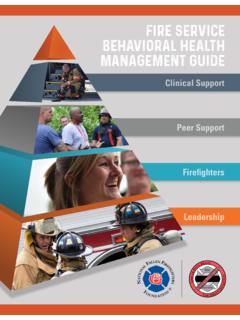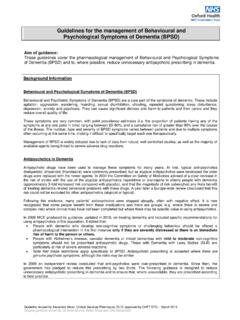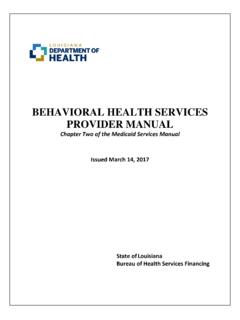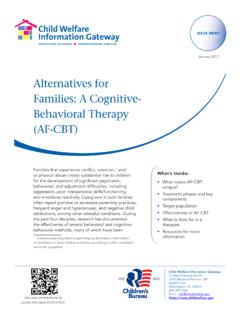Transcription of CHAPTER Classification and Assessment of Abnormal …
1 CHAPTERC lassification and Assessment of Abnormal BehaviorCHAPTER OUTLINEHOW ARE Abnormal BEHAVIOR PATTERNSCLASSIFIED? 70 77 The DSMand Models of Abnormal BehaviorSTANDARDS OF Assessment 77 80 ReliabilityValidityCognitive AssessmentPhysiological MeasurementSOCIOCULTURAL AND ETHNIC FACTORSIN Assessment 99 100 SUMMING UP 100 101 METHODS OF Assessment 80 99 The Clinical InterviewComputerized InterviewsPsychological TestsNeuropsychological AssessmentBehavioral 28-09-2007 14:34 Page 6869T F Some men in India have a psycho-logical disorder characterized by anxiety overlosing semen. (p. 74)T F Although it is not an exact science,the measurement of the bumps on a person shead can be used to determine the person spersonality traits. (p. 80)T F An objective test of personality isone that does not require any subjectivejudgments on the part of the person takingthe test. (p. 84)T F One of the most widely usedpersonality tests asks people to interpretwhat they see in a series of inkblots.
2 (p. 88)T F People in weight-loss programs whocarefully monitor what they eat tend to loseless weight than people who are less-reliablemonitors. (p. 94)T F Despite advances in technology,physicians today must still perform surgery tostudy the workings of the brain. (p. 96)T F Cocaine cravings in people addictedto cocaine have been linked to parts of thebrain that are normally activated duringpleasant emotions. (p. 99)FICTIONTRUTHor Jerry Has a Panic Attack on theInterstate Interviewer:Can you tell me a bit about what it was that brought you to the clinic?Jerry:Well, .. after the first of the year, I started getting these panic didn t know what the panic attack :Well, what was it that you experienced?Jerry:Uhm, the heart beating, racing ..Interviewer:Your heart started to race on :And then uh, I couldn t be in one place, maybe a movie, or a church ..things would be closing in on me and I d have to get up and :The first time that it happened to you, can you remember that?
3 Jerry:Uhm, yeah I was ..Interviewer:Take me through that, what you :I was driving on an interstate and, oh I might ve been on maybe 10 or15 :Uh :All of a sudden I got this fear. I started to .. uh :So you noticed you were frightened? :Your heart was racing and you were perspiring. What else?Jerry:Perspiring and uh, I was afraid of driving anymore on that interstate forthe fear that I would either pull into a car head on, so uhm, I just, I justcouldn t function. I just couldn t :What did you do?Jerry:I pulled, uh well at the nearest exit. I just got off .. uh stopped and,I had never experienced anything like that :That was just a ..Jerry:Out of the clear blue ..Interviewer:Out of the clear blue? And what d you think was going on?Jerry:I had no :You just knew you were ..Jerry:I thought maybe I was having a heart :Exerpted from Panic Disorder: The Case of Jerry, found on the Videos in AbnormalPsychologyCD-ROM that accompanies this BEGINS TO TELL HIS STORY,GUIDED BY THE AND OTHER mental health professionals use clinical interviews and a variety of other means toassess Abnormal behavior, including psychological testing, behavioral Assessment , andphysiological monitoring.
4 The clinical interview is an important way of assessingabnormal behavior and arriving at a diagnostic impression in this case, panic disor-der. The clinician matches the presenting problems and associated features with a setof diagnostic criteria in forming a diagnostic diagnosis of psychological or mental disorders represents a way of classifyingpatterns of Abnormal behavior on the basis of their common features or behavior has been classified since ancient times. Hippocrates classifiedabnormal behaviors according to his theory ofhumors(vital bodily fluids). Althoughhis theory proved to be flawed, Hippocrates Classification of some types of mentalhealth problems generally correspond to diagnostic categories we use today. His descrip-tion of melancholia, for example, is similar to our current conception of 28-09-2007 14:34 Page 6970 CHAPTER 3 During the Middle Ages some authorities classified Abnormal behaviors into twogroups, those that resulted from demonic possession and those due to natural 19th-century German psychiatrist Emil Kraepelin was the first modern theoristto develop a comprehensive model of Classification based on the distinctive features, orsymptoms, associated with Abnormal behavior patterns (see CHAPTER 1).
5 The mostcommonly used Classification system today is largely an outgrowth and extension ofKraepelin s work: the Diagnostic and Statistical Manual of Mental Disorders (DSM),published by the American Psychiatric is it important to classify Abnormal behavior? For one thing, Classification is thecore of science. Without labeling and organizing patterns of Abnormal behavior,researchers could not communicate their findings to one another, and progress towardunderstanding these disorders would come to a halt. Moreover, important decisions aremade on the basis of Classification . Certain psychological disorders respond better to onetherapy than another or to one drug than another. Classification also helps clinicians pre-dict behavior: schizophrenia, for example, follows a more or less predictable , Classification helps researchers identify populations with similar patterns ofabnormal behavior.
6 By classifying groups of people as depressed, for example, researchersmight be able to identify common factors that help explain the origins of CHAPTER reviews the Classification and Assessment of Abnormal behavior, begin-ning with the ARE Abnormal BEHAVIOR PATTERNS CLASSIFIED?The DSMwas introduced in 1952. The latest version, published in 2000, is the DSM-IV-TR,the Text Revision (TR) of the Fourth Edition (DSM-IV) (APA, 2000). Anothercommon system of Classification , published by the World Health Organization, is usedmainly for compiling statistics on the worldwide occurrence of disorders: theInternational Statistical Classification of Diseases and Related Health Problems (ICD),which is now in its tenth revision (the ICD-10). The DSM-IVis compatible with theICD, so that DSMdiagnoses could be coded in the ICDsystem as well. Thus the twosystems can be used to share information about the prevalences and characteristics ofparticular disorders.
7 The DSMhas been widely adopted by mental health , many psychologists and other professionals criticize the DSMon severalgrounds, such as relying too strongly on the medical model. Our focus on the DSMreflects recognition of its widespread use, not an the DSM, Abnormal behavior patterns are classified as mental disorders. Mentaldisordersinvolve either emotional distress (typically depression or anxiety), signifi-cantly impaired functioning (difficulty meeting responsibilities at work, in the family,or in society at large), or behavior that places people at risk for personal suffering, pain,disability, or death ( , suicide attempts, repeated use of harmful drugs).Let us also note that a behavior pattern that represents an expected or culturallyappropriate response to a stressful event, such as signs of bereavement or grief follow-ing the death of a loved one, is not considered disordered within the DSM, even ifbehavior is significantly impaired.
8 If a person s behavior remains significantlyimpaired over an extended period of time, however, a diagnosis of a mental disordermight become DSMand Models of Abnormal BehaviorThe DSMsystem, like the medical model, treats Abnormal behaviors as signs or symp-toms of underlying disorders or pathologies. However, the DSMdoes not assume thatabnormal behaviors necessarily reflect biological causes or defects. It recognizes thatthe causes of most mental disorders remain uncertain: Some disorders may havepurely biological causes, whereas others may have psychological causes. Still others,probably most, are best explained within a multifactorial model that takes into accountthe interaction of biological, psychological , social (socioeconomic, sociocultural, andethnic), and physical environmental 28-09-2007 14:34 Page 70 Classification and Assessment of Abnormal Behavior71 The authors of the DSMrecognize that their use of the term mental disorderis prob-lematic because it perpetuates a long-standing but dubious distinction between mentaland physical disorders (American Psychiatric Association, 1994, 2000).
9 They point outthat there is much that is physical in mental disorders and much that is mental in physical disorders. The diagnostic manual continues to use the term mental disorderbecause its developers have not been able to agree on an appropriate substitute. In thistext we use the term psychological disorderin place ofmental disorderbecause we feel itis more appropriate to place the study of Abnormal behavior more squarely within apsychological context. Moreover, the term psychologicalhas the advantage of encom-passing behavioral patterns as well as strictly mental experiences, such as emotions,thoughts, beliefs, and should also recognize that the DSMis used to classify disorders, not than classify someone as a schizophrenic or a depressive,we refer to an individ-ual with schizophreniaor a person with major depression. This difference in terminol-ogy is not simply a matter of semantics. To label someone a schizophrenic carries anunfortunate and stigmatizing implication that a person s identity is defined by the dis-order he or she of the DSMThe DSMis descriptive, not explanatory.
10 It describes the diag-nostic features or, in medical terms, symptoms of Abnormal behaviors; it does notattempt to explain their origins or adopt any particular theoretical framework, such aspsychodynamic or learning theory. Using the DSMclassification system, the clinicianarrives at a diagnosis by matching a client s behaviors with the criteria that define par-ticular patterns of Abnormal behavior ( mental disorders ). Table shows the diag-nostic criteria for generalized anxiety behavior patterns are categorized according to the features they example, Abnormal behavior patterns chiefly characterized by anxiety, such aspanic disorder or generalized anxiety disorder (see Table ), are classified as anxietydisorders. Behaviors chiefly characterized by disruptions in mood are categorized asmood disorders. The DSMrecommends that clinicians assess an individual s mentalstate according to five factors, or axes.
















